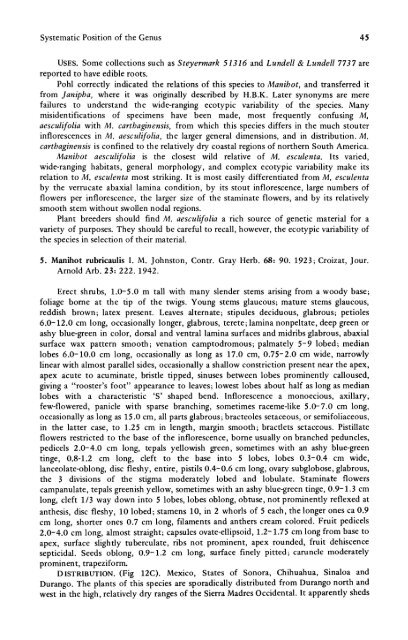Manihot Manihotoides (Euphorbiaceae) - CNCFlora
Manihot Manihotoides (Euphorbiaceae) - CNCFlora
Manihot Manihotoides (Euphorbiaceae) - CNCFlora
Create successful ePaper yourself
Turn your PDF publications into a flip-book with our unique Google optimized e-Paper software.
Systematic Position of the Genus 45<br />
USES. Some collections such as Steyermark 51316 and Lundell & Lundell 7737 are<br />
reported to have edible roots.<br />
Pohl correctly indicated the relations of this species to <strong>Manihot</strong>, and transferred it<br />
from Janipha, where it was originally described by H.B.K. Later synonyms are mere<br />
failures to understand the wide-ranging ecotypic variability of the species. Many<br />
misidentifications of specimens have been made, most frequently confusing M,<br />
aesculifolia with M. carthaginensis, from which this species differs in the much stouter<br />
inflorescences in M. aesculifolia, the larger general dimensions, and in distribution. M.<br />
carthaginensis is confined to the relatively dry coastal regions of northern South America.<br />
Manibot aesculifolia is the closest wild relative of M. esculenta. Its varied,<br />
wide-ranging habitats, general morphology, and complex ecotypic variability make its<br />
relation to M. esculenta most striking. It is most easily differentiated from M. esculenta<br />
by the verrucate abaxial lamina condition, by its stout inflorescence, large numbers of<br />
flowers per inflorescence, the larger size of the staminate flowers, and by its relatively<br />
smooth stem without swollen nodal regions.<br />
Plant breeders should find M. aesculifolia a rich source of genetic material for a<br />
variety of purposes. They should be careful to recall, however, the ecotypic variability of<br />
the species in selection of their material.<br />
5. <strong>Manihot</strong> rubricaulis I. M. Johnston, Contr. Gray Herb. 68: 90. 1923; Croizat, Jour.<br />
Arnold Arb. 23: 222. 1942.<br />
Erect shrubs, 1.0-5.0 m tall with many slender stems arising from a woody base;<br />
foliage borne at the tip of the twigs. Young stems glaucous; mature stems glaucous,<br />
reddish brown; latex present. Leaves alternate; stipules deciduous, glabrous; petioles<br />
6.0-12.0 cm long, occasionally longer, glabrous, terete; lamina nonpeltate, deep green or<br />
ashy blue-green in color, dorsal and ventral lamina surfaces and midribs glabrous, abaxial<br />
surface wax pattern smooth; venation camptodromous; palmately 5-9 lobed; median<br />
lobes 6.0-10.0 cm long, occasionally as long as 17.0 cm, 0.75-2.0 cm wide, narrowly<br />
linear with almost parallel sides, occasionally a shallow constriction present near the apex,<br />
apex acute to acuminate, bristle tipped, sinuses between lobes prominently calloused,<br />
giving a "rooster's foot" appearance to leaves; lowest lobes about half as long as median<br />
lobes with a characteristic 'S' shaped bend. Inflorescence a monoecious, axillary,<br />
few-flowered, panicle with sparse branching, sometimes raceme-like 5.0-7.0 cm long,<br />
occasionally as long as 15.0 cm, all parts glabrous; bracteoles setaceous, or semifoliaceous,<br />
in the latter case, to 1.25 cm in length, margin smooth; bractlets setaceous. Pistillate<br />
flowers restricted to the base of the inflorescence, borne usually on branched peduncles,<br />
pedicels 2.0-4.0 cm long, tepals yellowish green, sometimes with an ashy blue-green<br />
tinge, 0.8-1.2 cm long, cleft to the base into 5 lobes, lobes 0.3-0.4 cm wide,<br />
lanceolate-oblong, disc fleshy, entire, pistils 0.4-0.6 cm long, ovary subglobose, glabrous,<br />
the 3 divisions of the stigma moderately lobed and lobulate. Staminate flowers<br />
campanulate, tepals greenish yellow, sometimes with an ashy blue-green tinge, 0.9-1.3 cm<br />
long, cleft 1/3 way down into 5 lobes, lobes oblong, obtuse, not prominently reflexed at<br />
anthesis, disc fleshy, 10 lobed; stamens 10, in 2 whorls of 5 each, the longer ones ca 0.9<br />
cm long, shorter ones 0.7 cm long, filaments and anthers cream colored. Fruit pedicels<br />
2.0-4.0 cm long, almost straight; capsules ovate-ellipsoid, 1.2-1.75 cm long from base to<br />
apex, surface slightly tuberculate, ribs not prominent, apex rounded, fruit dehiscence<br />
septicidal. Seeds oblong, 0.9-1.2 cm long, surface finely pitted; caruncle moderately<br />
prominent, trapeziform.<br />
DISTRIBUTION. (Fig 12C). Mexico, States of Sonora, Chihuahua, Sinaloa and<br />
Durango. The plants of this species are sporadically distributed from Durango north and<br />
west in the high, relatively dry ranges of the Sierra Madres Occidental. It apparently sheds

















